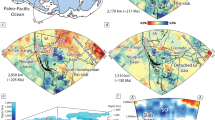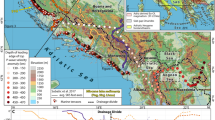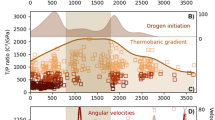Abstract
Since the first reconstruction of the supercontinent Pangaea, key advances in plate tectonic reconstructions have been made1,2,3,4,5,6. Although the movement of tectonic plates since the start of the mid-Cretaceous period (∼100 million years (Myr) ago) is relatively well understood1,2, the longitudinal position of plates before this period is not constrained at all. Here, we use a global mantle tomography model7 to estimate the longitude of past oceanic subduction zones. We identify 28 remnants of oceanic plates that were subducted into the lower mantle and link these to the mountain building zones from which they are likely to have originated. Assuming that these remnants sank vertically through the mantle, we reconstruct the longitude at which they were subducted. Our estimates for the location of the subduction zones are offset by up to 18∘ compared with plate tectonic reconstructions for the corresponding period. We did not detect oceanic plate remnants from the Carboniferous period (∼300–360 Myr ago), or before, suggesting that the tomographic visibility of subduction is limited to the past 300 Myr.
This is a preview of subscription content, access via your institution
Access options
Subscribe to this journal
Receive 12 print issues and online access
$259.00 per year
only $21.58 per issue
Buy this article
- Purchase on Springer Link
- Instant access to full article PDF
Prices may be subject to local taxes which are calculated during checkout




Similar content being viewed by others
References
Müller, R., Royden, J. & Lawver, L. Revised plate motions relative to the hotspots from combined Atlantic and Indian Ocean hotspot tracks. Geology 21, 275–278 (1993).
Norton, I. The History of Global Plate Motions 339–357 (Geophysical Monograph Vol. 121, 1996).
Torsvik, T., Müller, R., van der Voo, R., Steinberger, B. & Gaina, C. Global plate motion frames: Toward a unified model. Rev. Geophys. 46, 1–44 (2008).
Steinberger, B. & Torsvik, T. Absolute plate motions and true polar wander in the absence of hotspot tracks. Nature 452, 620–624 (2008).
Stampfli, G. & Borel, G. D. The TRANSMED Transects in Space and Time: Constraints on the Paleotectonic Evolution of the Mediterranean Domain: The TRANSMED Atlas Ch. 3 (Springer, 2004).
Scotese, C. Atlas of Earth History (PALEOMAP Project, 2001).
Amaru, M. Global Travel Time Tomography With 3-D Reference Models, Geol. Traiectina. PhD thesis, Utrecht Univ. 1–174 (2007).
Grand, S., van der Hilst, R. & Widiyantoro, S. Global seismic tomography: A snapshot of convection in the earth. GSA Today 7, 1–7 (1997).
van der Voo, R., Spakman, W. & Bijwaard, H. Mesozoic subducted slabs under Siberia. Nature 397, 246–249 (1999).
van der Voo, R., Spakman, W. & Bijwaard, H. Tethyan slabs under India. Earth Planet. Sci. Lett. 171, 7–20 (1999).
van Hinsbergen, D., Hafkenscheid, E., Spakman, W., Meulenkamp, J. & Wortel, M. Nappe stacking resulting from subduction of oceanic and continental lithosphere below Greece. Geology 33, 325–328 (2005).
Hafkenscheid, E., Wortel, M. & Spakman, W. Subduction history of the Tethyan region derived from seismic tomography and tectonic reconstructions. J. Geophys. Res. 111, B08401 (2006).
Sigloch, K., McQuarrie, N. & Nolet, G. Two-stage subduction history under North America inferred from multiple-frequency tomography. Nature Geosci. 1, 458–462 (2008).
Schellart, W., Kennett, B., Spakman, W. & Amaru, M. Plate reconstructions and tomography reveal a fossil lower mantle slab below the Tasman Sea. Earth Planet. Sci. Lett. 278, 143–151 (2009).
De Jonge, M., Wortel, M. & Spakman, W. From tectonic reconstruction to upper mantle model: An application to the Alpine–Mediterranean region. Tectonophysics 223, 53–65 (1993).
Hall, R. & Spakman, W. Subducted slabs beneath the eastern Indonesia-Tonga region: Insights from tomography. Earth Planet. Sci. Lett. 201, 321–336 (2002).
Torsvik, T., Steinberger, B., Cocks, L. & Burke, K. Longitude: Linking Earth’s ancient surface to its deep interior. Earth Planet. Sci. Lett. 276, 273–282 (2008).
Steinberger, B. Slabs in the lower mantle—results of dynamic modelling compared with tomographic images and the geoid. Phys. Earth Planet. Inter. 118, 241–257 (2000).
Golonka, J. et al. Paleogeographic reconstructions and basins development of the Arctic. Mar. Petrol. Geol. 20, 211–248 (2003).
Nokleberg, W. et al. Phanerozoic tectonic evolution of the circum-north Pacific. USGS Professional Paper 1626 (2000).
Cawood, P. & Buchan, C. Linking accretionary orogenesis with supercontinent assembly. Earth Sci. Rev. 82, 217–256 (2007).
Bijwaard, H., Spakman, W. & Engdahl, E. Closing the gap between regional and global travel time tomography. J. Geophys. Res. 103, 30055–30078 (1998).
Liati, A., Gebauer, D. & Fannink, C. The age of ophiolitic rocks of the Hellenides (Vourinos, Pindos, Crete): First U-Pb ion microprobe (SHRIMP) zircon ages. Chem. Geol. 207, 171–188 (2004).
DeCelles, P., Ducea, M., Kapp, P. & Zandt, G. Cyclicity in Cordilleran orogenic systems. Nature Geosci. 2, 251–257 (2009).
van der Lee, S. & Nolet, G. Seismic image of the subducted trailing fragments of the Farallon plate. Nature 386, 266–269 (1997).
Ricard, Y., Richards, M., Lithgow-Bertollini, C. & Le Stunff, Y. A geodynamic model of mantle density heterogeneity. J. Geophys. Res. 98, 21895–21909 (1993).
Jarvis, G. & Lowman, J. Survival times of subducted slab remnants in numerical models of mantle flow. Earth Planet. Sci. Lett. 260, 23–36 (2007).
Chauvel, C., Lewin, E., Carpentier, M., Arndt, N. & Marini, J. Role of recycled oceanic basalt and sediment in generating the Hf–Nd mantle array. Nature Geosci. 1, 64–70 (2008).
Schaefer, B., Turner, S., Parkinson, I., Rogers, N. & Hawkesworth, C. Evidence for recycled Archaean oceanic mantle lithosphere in the Azores plume. Nature 420, 304–307 (2002).
Hauff, G., Hoernle, K., Tilton, G., Graham, D. & Kerr, A. Large volume recycling of oceanic lithosphere over short timescales: Geochemical constraints from the Caribbean Large Igneous Province. Earth Planet. Sci. Lett. 174, 247–263 (2000).
Acknowledgements
We would like to thank the various people of Shell in Rijswijk, the Netherlands, for the valuable discussions on regional geology, A. Crince for technical support and R. Hall and P. Cawood for fruitful comments. Part of this work was conducted under programmes of the Vening Meinesz School of Geodynamics (VMSG, Utrecht University) and the Netherlands Research Centre of Integrated Solid Earth Sciences (ISES). D.J.J.v.H. acknowledges an NWO-VENI grant. This paper contributes to the ESF EUROCORES programme TOPO-EUROPE.
Author information
Authors and Affiliations
Contributions
D.G.v.d.M. carried out the global tomographic slab identification, longitude correction and plate tectonic reconstruction modifications, partly during his sabbatical at the NGU. W.S. co-developed the tomographic model and the ideas underlying the research presented here. D.J.J.v.H. provided integration between surface geology, orogenesis and subduction. M.L.A. developed the tomographic model as part of her PhD work at Utrecht University. T.H.T. provided the plate tectonic reconstructions. The first three authors shared equally in writing the article.
Corresponding authors
Ethics declarations
Competing interests
The authors declare no competing financial interests.
Supplementary information
Supplementary Information
Supplementary Information (PDF 5632 kb)
Rights and permissions
About this article
Cite this article
van der Meer, D., Spakman, W., van Hinsbergen, D. et al. Towards absolute plate motions constrained by lower-mantle slab remnants. Nature Geosci 3, 36–40 (2010). https://doi.org/10.1038/ngeo708
Received:
Accepted:
Published:
Issue Date:
DOI: https://doi.org/10.1038/ngeo708
This article is cited by
-
Assessing plate reconstruction models using plate driving force consistency tests
Scientific Reports (2023)
-
Deconstructing plate tectonic reconstructions
Nature Reviews Earth & Environment (2023)
-
Ghost-arc geochemical anomaly at a spreading ridge caused by supersized flat subduction
Nature Communications (2023)
-
Paleogene India-Eurasia collision constrained by observed plate rotation
Nature Communications (2023)
-
Global seismic tomography reveals remnants of subducted Tethyan oceanic slabs in the deep mantle
Science China Earth Sciences (2023)



